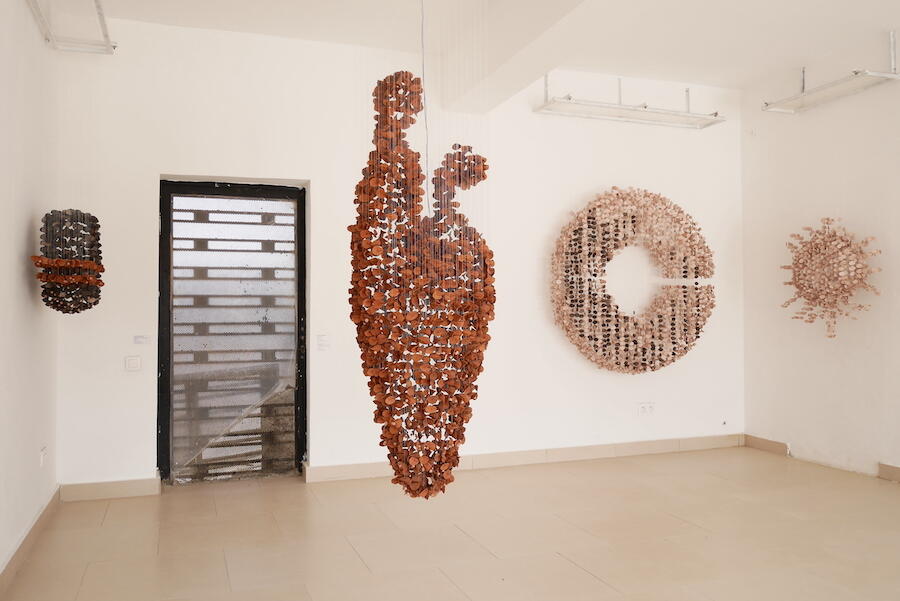Dak’Art Shines a Light on Contemporary Art in Senegal
The biennial, returning to the Senegalese capital for its 14th edition, offers visitors multiple perspectives of contemporary art practice in West Africa and further afield
The biennial, returning to the Senegalese capital for its 14th edition, offers visitors multiple perspectives of contemporary art practice in West Africa and further afield

Along with Mali’s photographic Les Rencontres de Bamako, Senegal’s Dak’Art is one of the longest-running biennials on the African continent. Founded in 1989, Dak’Art sought to create a platform for new approaches to the making of contemporary art in Africa. The event’s roots can be traced back to the First World Festival of Black Arts, which was held in Senegal’s capital, Dakar, in April 1966, and initiated by the country’s first president, Léopold Sédar Senghor. In the 1930s, Senghor – a cultural theorist and poet as well as a politician – had been instrumental to the development of the anti-colonial, Black consciousness-raising Négritude movement, and three decades later was helping create the conditions in Senegal for a national art scene to thrive among the country’s elite.

In the 1970s, the Dakar-based art collective Laboratoire Agit’Art (established by artist Issa Samb, filmmaker Djibril Diop Mambéty and playwright Youssouopha Dione) began to challenge Négritude as part of an attempt to revitalize artistic production with diverse performances and workshops that offered critiques of prevailing philsophies. The cultural legacies of Négritude, the First World Festival and Laboratoire Agit’Art all help describe the journey Senegalese society has taken from the colonial period into modernism and through to the post-colonial – and continue to have an impact on the country’s contemporary art scene.
I first visited Dakar as part of a research trip to West Africa in 2019. It appeared then that interesting new work in the arts was being spearheaded mostly by non-governmental organizations such as Village des Arts, Maison Aïssa Dione, RAW Material Company, Espace Medina, Laboratoire Agit'Art and Atelier Céramiques Almadies. On this year’s return visit to Senegal, to attend Dak’Art 2022 (its 14th edition, delayed for two years due to the COVID-19 pandemic), I was staggered both by the volume and quality of visual arts output that the biennial represented. The evidence was not just in Dakar (at venues including the Institut Fondamental d’Afrique Noir (IFAN) and Maison de la Culture Douta Seck), but also at Les Manufactures Sénégalaises des Arts Décoratifs in Thiès, a city around 35 miles west of the capital.

The theme of 2022’s Dak’Art, ‘Ĩ’Ndaffa / Forger / Out of the fire’, is suggestive of multiple creative possibilities as well as acts of transformation. A commitment to creative potential and forging new imaginaries are central to the thesis put forward by the biennial’s artistic director, Dr El Hadji Malick Ndiaye. His use of Ĩ’Ndaffa in naming the event – a word in the Serer language (spoken in both Senegal and the Gambia) meaning ‘to forge’, and which denotes the action of creating, recreating and kneading – marks it as an event that calls artists to return to thinking in the context of their mother tongues, as opposed to the languages introduced to Senegal through colonialism.
The biennial’s main exhibition in Dakar, held at the Palais de Justice, features work by 59 artists from over 50 different African countries, and from the African diaspora. Highlights include Florine Démosthène’s ethereal collage self-portraits that explore themes of race and gender, and an installation by art collective Troubled Archive that interrogates the invention of colonial clichés through photography and archives found in European museums. This central show also features both recent and new large-scale textile works by Malian artist Abdoulaye Konaté (winner of the biennale’s Grand Prize in 1996), in a meditative display of abstract woven tableaus that speak to sociopolitical themes whose resonance extends far beyond the local. ‘Black Rock 40’, a showcase of work by past incumbents of an artist-in-residence programme of the same name founded by American artist Kehinde Wiley in 2019, includes pieces by Tunji Adeniyi-Jones, Zohra Opoku, Kambui Olujimi, as well as Collectif Ban, a group of four young Senegalese ceramicists who opened a new ceramics space in Dakar, Ban Workshop, in 2020, with the intention of preserving and reinterpreting centuries-old ancestral ceramic practices.

Now in its 20th year, LE OFF, the biennial’s expansive programme of satellite events (over 400 venues are registered this year), extends beyond Dakar to Senegal’s Petit Côte region and the northern city of St Louis. LE OFF's standout presentation was at Selebe Yoon: ‘Now/Naaw’, a retrospective of artist El Hadji Sy’s work whose title contains a word in Wolof (a language spoken in Senegal, Mauritania and the Gambia) that translates as ‘to fly’; Sy’s painted kites take over the gallery’s interconnected spaces and stairwell. Another impressive presentation, over two venues, was orchestrated by Aissa Dione, founder of Dakar’s Galerie Atiss: a showcase of 15 local and international artists that includes Elolo Bosoka, a young Ghanaian artist who has fashioned monumental sculptures from discarded sacks; painter Ngimbi (Luve) Bakambana, whose vibrant paintings reflect on the body and interior scenes; and Serigne Mbaye Camara, whose large-scale black-and-white drawings and assemblages of varying scales deftly respond to the show’s theme of interwoven meanings, past and present.
Together, Dak’Art and LE OFF offer an impressive showcase of what can be produced by the ecosystem of sharing that characterizes Dakar’s contemporary art scene. As Marie Hélène Pereira, director of programs at RAW Material Company, said when talking about how important the biennial’s programme was for bringing new voices into focus: ‘…independent art initiatives and institutions continue to shake the ground with thoughtful proposals for exhibitions and live events that took place all over the city. The future of the arts in Senegal is sitting in the hands of its young creative minds.’
The 14th edition of Dak'Art Biennale of Contemporary African Art is on view until 21 June
Main image: El Hadji Sy, 'Now/Naaw', 2022, installation view. Courtesy: Selebe Yoon, Dakar





















